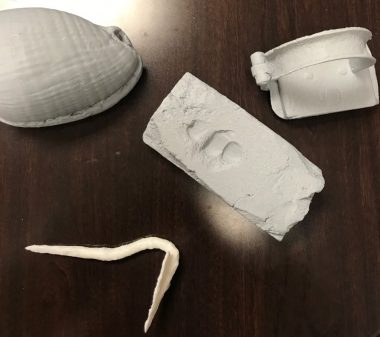History professor Charles Irons used 3D printed artifacts from the Maker Hub to teach students about slavery in 19th century America.
By Elizabeth Kirkhorn, '19
When teaching Elon undergraduates about enslavement in 19th century America, Professor of History Charles Irons aspired to bring the era to life in the classroom.
He wanted his students to think more concretely about the realities of slavery that can be difficult to grasp. This quest led Irons to incorporate 3D-printed artifacts from the time period into his teaching.

Irons assigned student employee Martha Selph, who works in the Department of History and Geography, the task of printing four replicas at the Maker Hub. Those items included a broken hoe discovered on a plantation in Virginia, a cowrie shell used as currency by an African population, shackles used in the internal slave trade, and a brick that displays the imprints of an enslaved person’s fingers.
The brick, Irons said, was the “star of the show.”
“It’s my favorite, and for many people, deeply moving,” he said. “But all of these things were meaningful for people to touch and imagine. Slavery isn’t only a theoretical issue. It had a material reality.”
After handling the items, Irons prompted students to complete a writing assignment connecting an artifact of their choice to course themes.
“We talked about the second middle passage, the internal slave trade. They knew some of the statistics; they knew why it happened, when it happened and where,” Irons said. “But to actually feel the shackles they would have used, and to think about that.”

Irons is a proponent of tactile engagement in the classroom, given the success he's seen with 3D printing of historical objects. Virtual environments that students can explore using headsets are trendy and immersive, he said, they are often too time-consuming for professors to set up and employ.
“I really like the VCU program, because it makes [tactile engagement] possible and worth it,” he said. “It’s valuable, and you don’t have to pay to use it.”
Selph, who was tasked with digitally printing the artifacts, did not have prior experience with 3D printers, but said with the help of the Maker Hub staff and “trial and error,” it was a success.
“I think 3D printing could benefit the History Department by allowing students to have a literal hands-on experience with artifact replicas,” Selph said. “It could bring history to life for more visual learners.”
For Irons, the hope is for technology to continuously make deep-dive learning feasible. Meanwhile, he seeks to further incorporate 3D printing into his pedagogy. He recalled having recently heard of an object described as a fragment of a shackle that had been repurposed into a necklace, with initials and the date inscribed.
“Folks have hypothesized, really compellingly, that the initials and the date match an insurrection in Jamaica,” he said. “All of a sudden, this object tells a broader story of resistance, and awareness, and Pan-African sensibility. To be able to digitally print an object I could use to talk about stuff like that would be unbelievable.”


